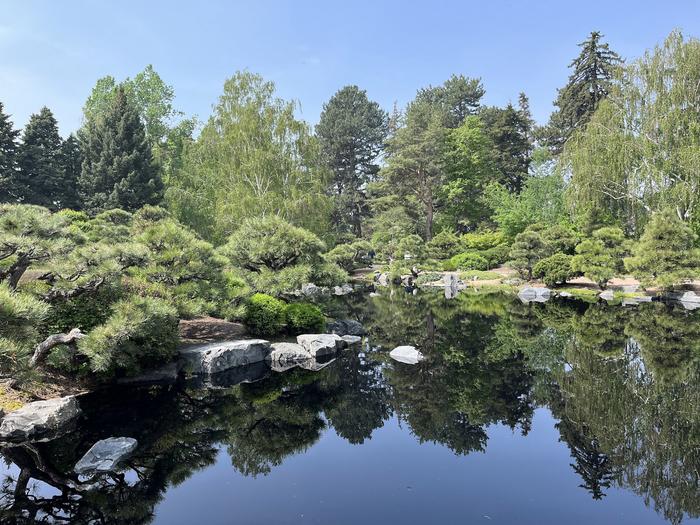During his recent yearlong sabbatical, Daniel Laughlin led a study that found trees can sustain life in temperatures higher or lower than where they are currently growing.

Credit: Daniel Laughlin
During his recent yearlong sabbatical, Daniel Laughlin led a study that found trees can sustain life in temperatures higher or lower than where they are currently growing.
While tree species appear to prefer distinct climatic conditions, the true nature of these preferences is obscured by species interactions and dispersal, which limit tree species’ ranges.
“We were amazed. The result was crystal clear, and that doesn’t always happen in ecology,” says Laughlin, a professor in the University of Wyoming Department of Botany. “We found that tree species could grow and survive at one common moderate temperature, even though many species are only found in either cold or warm environments. In fact, many trees could expand their ranges by more than 25 percent based on their potential temperature tolerances.”
Laughlin is lead author of a paper titled “Trees have overlapping potential niches that extend beyond their realized niches” that was published today (July 5) in Science, a weekly peer-reviewed academic journal of the American Association for the Advancement of Science that publishes important original scientific research.
Brian McGill, a professor in the School of Biology and Ecology at the University of Maine, is the paper’s co-author. Laughlin and McGill share a mutual interest in understanding how species will respond to rapid changes in climate. To make progress on this pressing problem, they studied occurrences of North American tree species in arboreta around the world to quantify their tolerance of extreme cold and heat.
The two researchers quantified realized and potential thermal niches of 188 North American tree species to conduct a continental-scale test of the architecture of niches, according to the study. The study included 23 tree species native to Wyoming, including Engelmann spruce, subalpine fir, limber pine, lodgepole pine, ponderosa pine, aspen, Rocky Mountain juniper and plains cottonwood.
The realized niche of a tree species is where you find it in nature, while the potential niche is where you could but don’t because it was outcompeted by other tree species or it could not disperse there, Laughlin says.
“For example, the realized niche of the Wyoming native tree Engelmann spruce includes high-elevation subalpine forests,” Laughlin explains. “However, the potential niche also includes warmer locations, such as along streambanks at lower elevations, where the trees could survive. But they are not found there because they get outcompeted by faster-growing cottonwoods.”
The two researchers found strong and consistent evidence that tree species occurring at thermal extremes occupy less than 75 percent of their potential niches, and species’ potential niches overlap at a mean annual temperature of 12 degrees Celsius, or roughly 55 degrees Fahrenheit.
“When we walk in the woods, we see with our own eyes that tree species occur in distinct places. This is a core tenet of ecology,” Laughlin says. “However, where species are actually found in nature is a fraction of their potential distribution because competition with other species and dispersal limitation constrain where they actually occur.”
The new results break a core assumption of most current methods for predicting species distributions, suggesting that ecologists need to get serious about quantifying the full range of environments that are tolerable to plants, Laughlin says.
“This is a critical missing piece of information for predicting how they respond to a warming world,” Laughlin says.
The results also suggest that tree species will have different fates. Cold-tolerant trees, such as Engelmann spruce and subalpine fir, may not need to move to stay within their climatic tolerances. However, warm-tolerant species, such as live oak and longleaf pine, will need to migrate.
“North American tree species have been navigating changing climatic conditions for millions of years. We know that, over long time spans, trees have moved across the continent to track suitable climate conditions, but we don’t know how this will play out over the next few decades and centuries,” Laughlin says. “For example, the climate in Laramie may soon be suitable for trees from the Southwest that are adapted to warmer conditions, but we are uncertain about which species will arrive first. Understanding the fundamental temperature tolerances of trees is an important first step to improving our predictions of how tree species’ ranges will shift over time.”
Laughlin’s sabbatical, which took place during the 2023-24 academic year, was supported by a UW Flittie Sabbatical Augmentation Award and a UW College of Agriculture, Life Sciences and Natural Resources Global Perspectives grant.
Journal
Science
DOI
10.1126/science.adm8671
Method of Research
Meta-analysis
Subject of Research
Not applicable
Article Title
Trees have overlapping potential niches that extend beyond their realized niches
Article Publication Date
5-Jul-2024




